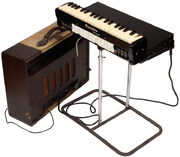
A pre-synthesizer electronic instrument invented by Constant Martin of France, shortly after World War II. The Clavioline was originally intended to be a complementary instrument to a piano, providing the ability to approximate the sound of certain orchestra instruments such as violin and brass. It was usually packaged in a shape such that it could be bolted to the underside of a piano's keyboard ledge, and the Clavioline's keys would protrude out from under the piano. It could also be mounted on a stand and played by itself. An amplifier came with the Clavioline keyboard, and was essential to playing the instrument since it contained the power supplies for the keyboard unit. The two connected via a multi-pin cable, and were often constructed such that they could be fastened together into a single unit for transport. All circuitry was implemented with vacuum tubes (valves), being that the transistor had not been invented yet.
The Clavioline was a monophonic instrument, based on divide-down circuitry driven by a high-frequency master oscillator; the basic waveform it delivered was an approximate square wave. Most versions had a three-octave keyboard, and a set of switches that could transpose the instrument up or down one octave, providing a total range of five octaves. (One of Harald Bode's first contributions to electronic music was a modification he developed that gave the Clavioline an additional octave of transpose range.) The basic version of the instrument had a set of 16 rocker switches, called "stops" after organ terminology, each of which switched in a High pass or lowpass filter with a certain cutoff frequency. By switching in various combinations of stops, formants could be created which could approximate the resonances of real or imaginary acoustic instruments. There were also switches that could impose a mild, fixed-frequency vibrato on the master oscillator in various amounts; this became a distinctive part of the Clavioline's sound. The performer's right leg served as the envelope generator; a knee lever underneath the keyboard controlled the output volume. It was necessary to apply some force to the lever to get any sound out. There was no master volume control on the keyboard, although the amplifier's output level could be adjusted.
The Clavioline design and name were licensed to a number of manufacturers in different countries, some of whom made changes to the basic design. The models produced by Selmer in the UK and Gibson in the USA were the best known. The Clavioline was quite popular in the late 1950s as it was regarded as having a "space age" sound. Production lasted until about 1965, by which time electronic organs had taken over most of the uses for which the Clavioline was used. Well known songs that used a Clavioline include The Beatles' "Baby You're A Rich Man" and The Tornadoes' "Telstar", the latter of which was played by Geoff Goddard. The solo on Del Shannon's "Runaway" was played by Max Crook on a Clavioline which he had modified and dubbed the Musitron.
A variation on the Clavioline was the Tuttivox, designed by Harald Bode. He replaced the single oscillator and divider of the Clavioline with a top octave division setup which made the instrument fully polyphonic; every note on the keyboard could sound at once. This in turn led to the development of the combo organ.